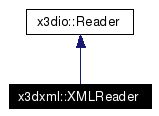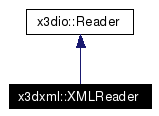
|
X3D libraries
The libraries to work with X3D dataset
|

|
x3dxml::XMLReader Class Reference
An implementation of x3dio::Reader used to read a stream and convert it to a tree of x3d nodes. More...
#include <xml.h>
Inheritance diagram for x3dxml::XMLReader:


Public Member Functions | |
| virtual x3d::SFNodePtr | Load (x3dio::Stream *stream, x3dio::ErrorCallback *callback=0) |
Load stream into a tree of nodes from an XML file. | |
| XMLReader () | |
| Initialize the XML reader. | |
| virtual | ~XMLReader () |
| Destroy the XML reader. | |
Detailed Description
An implementation of x3dio::Reader used to read a stream and convert it to a tree of x3d nodes.The XML reader is a very optimized XML parser which takes a wellformed X3D tree and loads it in an X3D tree of nodes. The input file is expected to be UTF-8.
See the Load() function for more information about the input file.
You can instantiate the class on your stack or create an object with the new operator.
x3dio::FileStream stream; stream.Open("my_shape.x3d"); x3dxml::XMLReader xml_out; // note: ignore errors x3d::SFNodePtr root = xml_out.Load(stream); ... // do something with root
- See also:
- XMLReader
Constructor & Destructor Documentation
|
|
Initialize the XML reader. The constructor will make sure that the reader is ready to be used. |
|
|
Destroy the XML reader. The destructor deletes all the objects used internally. |
Member Function Documentation
|
||||||||||||
|
Load
This function reads the input This means:
Save the specified (root) This function is expected to be implemented by different libraries supporting different file formats (such as XML, VRML, OBJ, RAW, etc.) The node is always expected to be a root node (i.e. an X3D node). If the node is not of the right type, the function should fail (thought some implementations may be capable of saving just a shape or some other X3D object). The user can specify an error callback object. In this case, any error generated in the writer will be reported to the caller. Please, see the reference about the x3dio::ErrorCallback for more information on how messages are forwarded.
Implements x3dio::Reader. |
The documentation for this class was generated from the following files:
